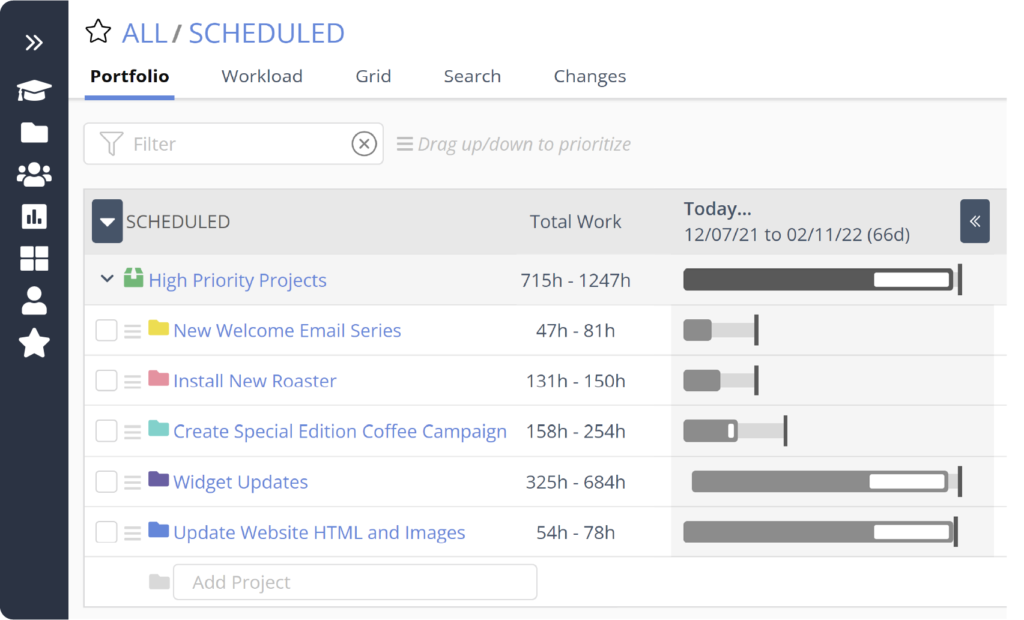Knowing how to prioritize work affects the success of your project, the engagement of your team, and your role as a leader. All projects—especially large, complex projects—need clear priorities. Easier said than done. Especially when every task appears to be priority number #1 and screaming for your attention. You can count on technical projects, no matter how well-planned, to involve change orders, re-prioritization and the regular appearance of surprises. It’s just the natural order of things.
Prioritization is the process of determining the level of importance and urgency of a task, thing or event. It’s a key skill for any working professional and is absolutely essential for project managers to master. Smart prioritization is a vital part of LiquidPlanner’s Planning Intelligence philosophy to align people, priorities and projects.
One of the biggest challenges for project managers and team leaders is accurately prioritizing the work that matters on a daily basis. Even if you have the best project management software, you’re the one who enters information into the tool. And, you don’t want to fall into the role of crying “top priority” for every other project that comes down the pike.
Just as you have to be diligent and have the right kind of project insight to ensure that nobody’s working on yesterday’s priorities. It takes a lot of practice and time management to get this right.
To help you manage your team’s workload and hit deadlines on time, here are 6 steps to prioritizing projects that have a lot of moving parts.
1. Collect a list of all your tasks.
Pull together everything you could possibly consider getting done in a day. Don’t worry about the order or the number of items upfront. This will help you frame up how and when to allocate your time wisely.
Having trouble organizing your tasks in one central location? Check out LiquidPlanner’s project management software which uses smart prioritization as one of it’s 6 Planning Intelligence solutions. It helps teams come up with more realistic estimates for your tasks while answering the question, when?
2. Identify urgent vs. important.
The next step is to see if you have any tasks that need immediate attention. We’re talking about work that, if not completed by the end of the day or in the next several hours, will have serious negative consequences (missed client deadline; missed publication or release deadlines, etc.).
Allocate time to prioritizing your most urgent tasks earlier in the day. If you push these to a later period, you’re at risk of being too busy as the day runs on. Prioritizing based on urgency also alleviates some of the stress when approaching a tight deadline or high pressure workload demands.
Check to see if there are any high-priority dependencies that rely on you finishing up a piece of work now. Be sure to contact any member of your team that can help finish any dependencies earlier in the day.

3. Assess the value of your tasks.
Take a look at your important work and identify what carries the highest value to your business and organization. As a general practice, you want to recognize exactly which types of tasks are critical and have top priority over the others.
For example, focus on client projects before internal work; setting up the new CEO’s computer before re-configuring the database; answering support tickets before writing training materials, and so on. Another way to assess value is to look at how many people are impacted by your work. In general, the more people involved or impacted, the higher the stakes.
Below are some helpful references to assess the value and importance of your tasks.
- Critical priorities are time sensitive and high value. These include tasks dealing with crises or strict client deadlines.
- High value tasks that are not time sensitive should be considered high priorities. These are tasks that involve thinking, planning and collaboration.
- Medium priorities can be time sensitive but not high in value. Meetings, email communications, and project organizing can fall into this category.
- Low priority projects and tasks are ones that are not time sensitive and do not have high value. You can push these priorities later in the week or drop them entirely.
4. Order tasks by estimated effort.
If you have tasks that seem to tie for priority standing, check their estimates, and start on whichever one you think will take the most effort to complete. Productivity experts suggest the tactic of starting the lengthier task first. But, if you feel like you can’t focus on your meatier projects before you finish up the shorter task, then go with your gut and do that. It can be motivating to check a small task off the list before diving into deeper waters.
Managing uncertainty is hard work. If you’re looking for more information on creating accurate project estimates, check out how LiquidPlanner utilizes Smart Estimation through our project management solution, Planning Intelligence.

5. Be flexible and adaptable.
Uncertainty and change are given. Know that your priorities will change, and often when you least expect them to. So plan for the unexpected. But—and here’s the trick—you also want to stay focused on the tasks you’re committed to completing. While working on such tasks, try to forecast other project requirements that will follow your priorities so you can better prepare for what lies ahead.
6. Know when to cut.
Be realistic. You probably can’t get to everything on your list. After you prioritize your tasks and look at your estimates, cut the remaining tasks from your list, and focus on the priorities that you know you must and can complete for the day. While cutting your prioritization list down, focus on the main things that will bring you feelings of accomplishment for the day. Then take a deep breath, dive in, and be ready for anything.
Get Smart Prioritization With LiquidPlanner

When everything feels like number one on your to-do list, it can be overwhelming. But remember, not everything on your list is, or should be, a priority. This is why it’s important to know how to identify your priorities and to differentiate between critical and low priorities.
With LiquidPlanner’s Planning Intelligence software, your organization’s project management priorities are factored into the schedule from the very beginning. Learn about our impact on your project portfolio when priorities shift by starting a free trial today.








